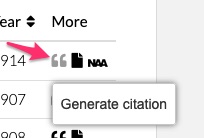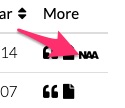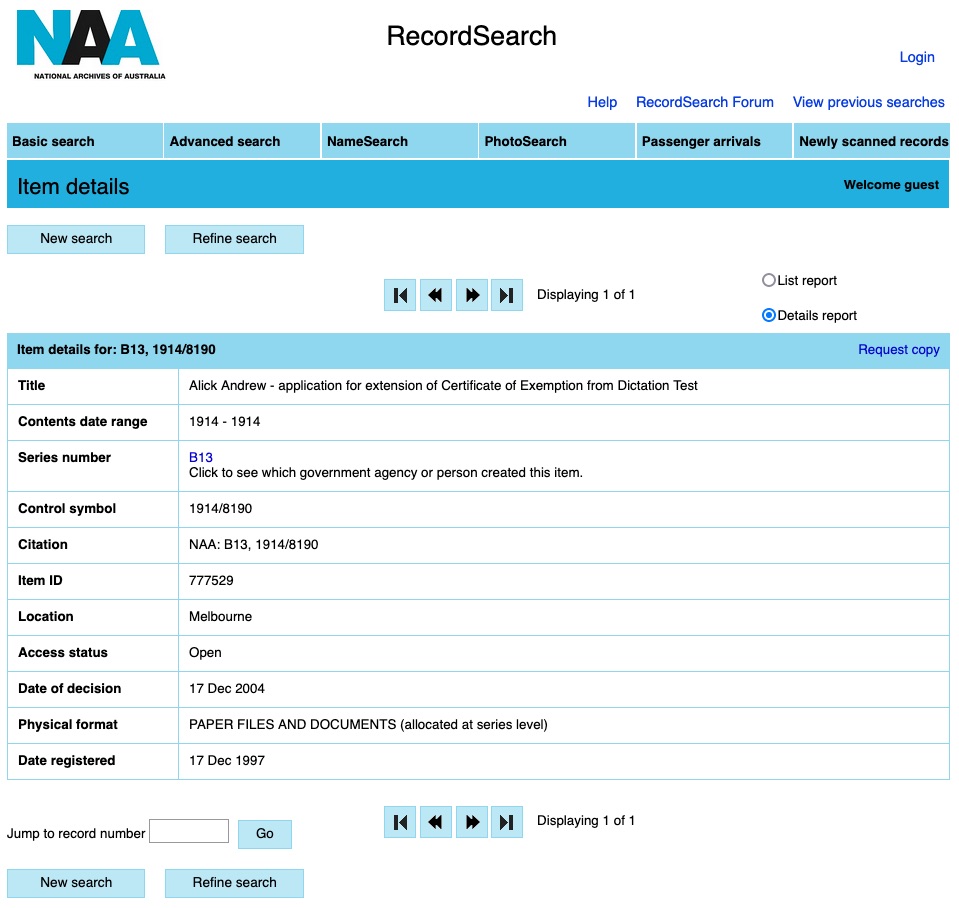Search Tool
Quick help

Follow these simple steps
- Enter a Name or search term in the text field
- Review the search results
- Open an image of the register page
- Filter your results with additional search criteria
Basic searching
Learn how to use the basic search tool.

Follow these examples.
| To find: | Select from the drop-down menus: | Type in: |
|---|---|---|
| A person with the name Chin | Name Using all my search words | Chin |
| A person with the name Ah Chin | Name Using my exact phrase | Ah Chin |
| A name starting with Chin | Name Starting with search words | Chin |
| A person who is a Gardener | Occupation Using all my search words | Gardener |
| A person who lives in Coburg | Residence Using all my search words | Coburg |
| A person who lives in Coburg in 1920 | Residence Using all my search words Specific Year | Coburg 1920 |
* Names with two words may require the selection of “Using my exact phrase”
** You can also use of advanced search operators ‘ AND ‘, ‘ OR ‘, ‘ NOT ‘ or ‘*’ in the search field. eg. Willie AND Dark
Advanced searching
Sorting results
If you have too many records in your search results, you can sort them by selecting the sort icon next to the column heading. They will be sorted in ascending or descending order.
Additional search criteria
You can also try filtering your results by using the Add new search criteria function.

Follow these examples.
| To find: | Select from the drop-down menu: | Type in: |
|---|---|---|
| A person with the name Chin living in Coburg | Name Using all my search words + AND Residence Using all my search words | Chin Coburg |
| A person with the name Chin living in Coburg who is also a gardener | Name Using all my search words + AND Residence Using all my search words + AND Occupation Using all my search words | Chin Coburg gardener |
| A person with the name Chin but do not include anyone named Ah Chin | Name Using all my search words + NOT Name Using my exact phrase | Chin Ah Chin |
Watch a video
Learn how to use the Search tool in this video (3 min.)
Use the full screen function to see a larger view.
Citations
Generate a citation for a specific record by selecting the corresponding citation icon.


You can copy this citation to be reused for your research reference documentation.
Viewing the Register page
See a copy of the register page by selecting the Open page image icon.
The image will open in a new tab.

These pages often provide more information.
NAA Record
The Victorian CEDT Index can also provide a link to the relevant item in the B13 Correspondence series in the National Archives of Australia (NAA) RecordSearch.

Not all records in the Index have a corresponding NAA record. We have matched records in the registers to the B13 record using the C&E number. If we have been able to match the C&E number with a file in the B13 series you will see NAA icon at the end of the record line.

It is still worth searching RecordSearch for the name of your ancestor in case they hold other files related to them.
FAQ
What does the Index allow you to search?
Our online index of the CEDT Registers allows you to search the following fields:
- Name
- Age
- Nation/Nationality
- Occupation
- Residence/Address (Suburb only)
To access other information in the register, such as travel information, notes and various numbers associated with applications you need to view the digital photograph of the register page.
Why is my ancestor’s name misspelt?
The Victorian CEDT Index records the names of people as they are spelt in the registers. An alternative spelling is provided where we have been unable to make out the writing in the registers.
There are many reasons why Chinese names are spelt in different ways. It is not always because recording officials were ignorant and wrong. Historians researching Chinese Australian always try different spellings of names. Sometimes you need to get creative!
Chinese languages are tonal and so there is no ‘correct’ romanised spelling of a Chinese name. Chinese names in English are therefore an approximation of what the name sounds like in the Chinese language or dialect it is spoken in. There can be different ways of spelling the same name depending on the language it was spoken in and the way the person chose to phonetically spell it.
Cantonese people are also well-known for adopting different names over their lifetimes and also using nicknames (see ‘Found: Louey Leong Hock’ blogpost and ‘Finding my Dad’ for examples of this). The reason why there are so many people with the name ‘Ah’ in their name is because this denotes that the following characters in the name is a given name and it is used as a familiar way of referring to that person.
For a discussion of Indian names in the registers see ‘Name variations of early Indians in Australia’ blogpost.
Why do some entries for ‘Residence’/’Address’ have two places listed, one in brackets?
Information provided by different clerks in the field ‘Residence’ or ‘Address’ changed over time. The registers record the suburb or town listed. Note that there are some towns listed that are outside Victoria.
From around 1935 clerks began to enter more detailed addresses for locations within metropolitan Melbourne. You need to view the digital photograph of the register page to see this additional information.
In the late 1910s clerks started to sometimes enter two place names in this field, one in brackets. These bracketed locations are listed in the Victorian CEDT Index. In some cases, it appears one is the suburb of the other, eg. Geelong (Chilwell), Melbourne (Brighton), Fitzroy (Melbourne), Kolora (Terang).
In other cases, the places are geographically separated. This perhaps indicates one place the person regularly lived and another where they were living when they applied for the CEDT, eg. Melbourne (Beulah), Fitzroy (Benalla District), Middle Park (Sale). You can browse a list of the places in the index here.
What does ‘Nation’ or ‘Nationality’ mean in the registers?
The concepts of ‘nationality’, ‘citizenship’, ‘subjecthood’ and ‘naturalisation’ are complex, overlapping and vary in different colonies/states at different times. They were entangled up legally, politically and colloquially with ideas of ‘race’ or ‘ethnicity’. Information provided in the registers in the ‘nationality’ or ‘nation’ field does not always follow the formal definition of this term and is mostly more closely aligned to perceived ‘race’.
Up until the Commonwealth Nationality and Citizenship Act 1948 anyone born in Australia was of British nationality by birth. Individuals not born in Australia could obtain citizenship through naturalization. In Victoria, from the mid-1880s Chinese applications for naturalization were refused by the Victorian government. This was an administrative, rather than legal decision.
In 1903 naturalization became the responsibility of the Commonwealth under the Naturalization Act 1903 which also denied naturalization to anyone who was ‘an aboriginal native of Asia, Africa, Islands of the Pacific, excepting New Zealand’ anywhere in Australia.
A range of terms related to race, birthplace and naturalization status are used under the field ‘Nation’/’Nationality’ (browse these terms here). These were not used consistently, and so users may well find the term used is in fact incorrect. We have kept the terms as used in the registers but it should be noted that the term ‘Half Caste’ is now considered offensive and there are also sensitivities around the use of ‘Hindoo’, ‘Indian’, ‘Sikh’, ‘Cingalese’/Singalese’ and ‘Syrian’ (see ‘Name variations of early Indians in Australia’ blogpost).
And as Mayu Kanamori’s blogpost, ‘But where is your home?’, reminds us citizenship and nationality are of course very different to the place or places that we might call ‘home’.
Why does it just say ‘n/a’?
Over 1,700 entries in the Victorian CEDT Index just contain the name of the person and perhaps their ‘nationality’. This is because there is no information about these fields in the register. If you view the digital photograph of the register page you will find more information about what has happened. Most likely an earlier CEDT application has been extended or the travel permission granted under ‘Circular 07/5519’. If an extension was granted the person had to pay a second fee and was generally permitted to stay away from Australia for a further three years. If they were travelling under ‘Circular 07/5519’ they were travelling on a naturalization certificate (see ‘Issued under Circular 07/5519 and Naturalization: Chin Nooey’ blogpost for more discussion about this).
What are the Victoria Numbers, CEDT Book Numbers and C&E Numbers?
The ‘Vic. No.’ is a consecutive number that starts again at the beginning of each year. Each new CEDT application has a new ‘Vic. No.’ which is made up of the year followed by this consecutive number separated by a backwards slash. This number was used to keep track of items listed in the Victorian CEDT Registers.
The’ CEDT Book No.’ refers to the number on the CEDT certificate. Certificates were cut from bound books with each book and certificate numbered. This number was used to keep track of the numbered certificates issued.
The ‘C&E File No.’ is a Department of Trade and Customs file number. This number is a reference to a file in the main correspondence series of the Collector of Customs in Melbourne. It is made up of ‘C&E’ followed by the year and a consecutive number separated by a backwards slash. This number was used to keep track of correspondence.
Fortunately, this correspondence series, B13, is also held by the National Archives of Australia in Melbourne. Unfortunately, it has been heavily culled. If you are lucky you might find a surviving file related to the CEDT listed in the Registers in the B13 series.
To learn more about how to use these numbers in your research see ‘Using Victoria, CEDT Book and C&E Numbers and Passenger lists: Mrs Lup Mun’ blogpost.